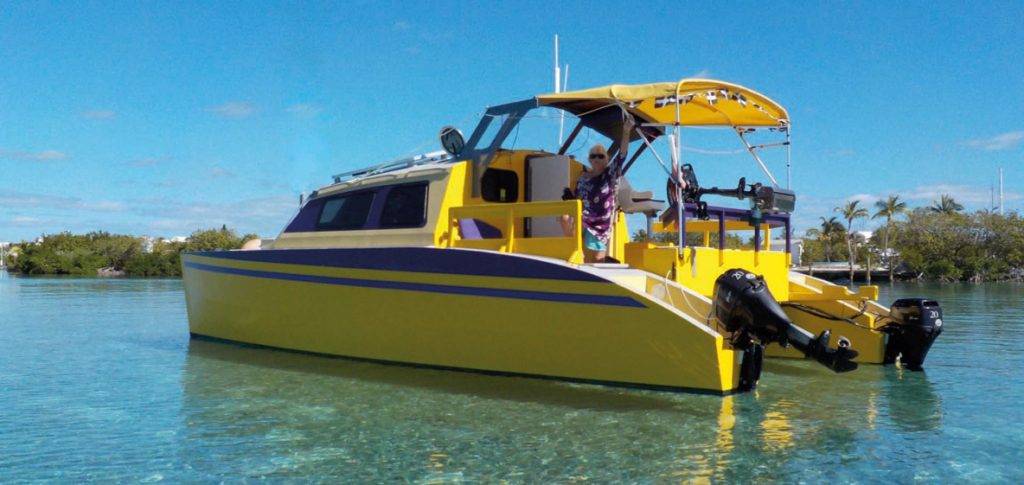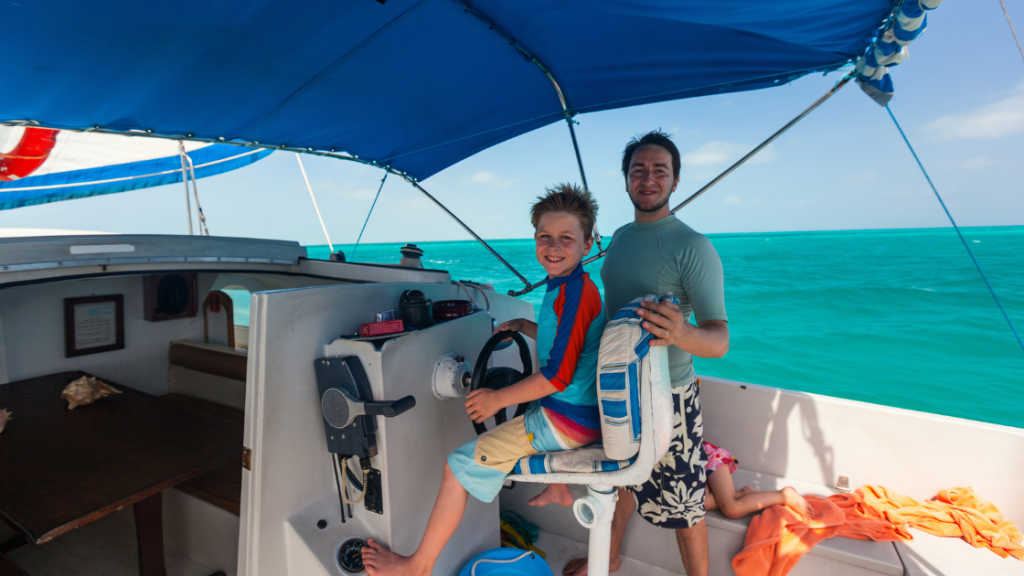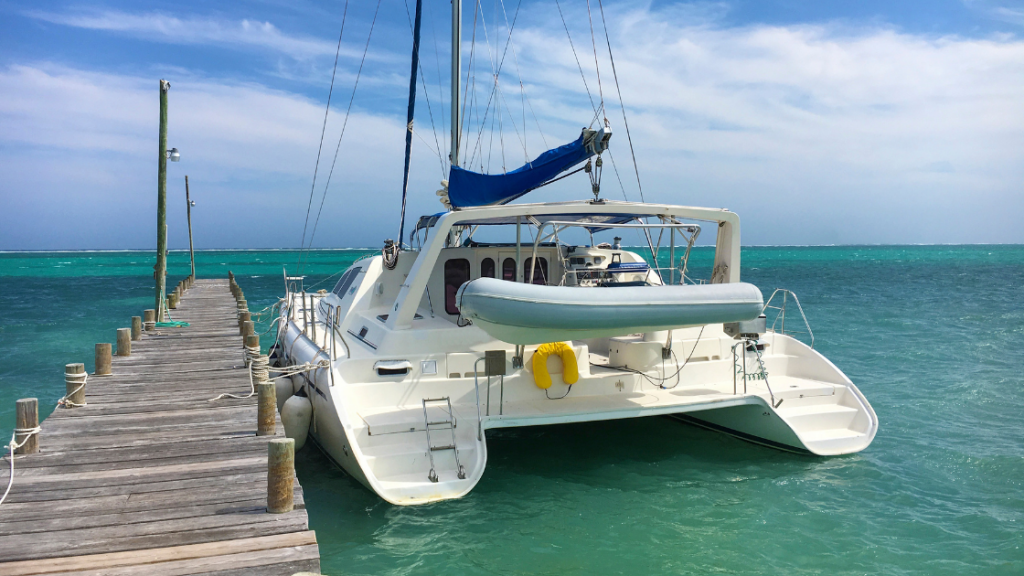Taking The Helm Of A Catamaran Might Be Easier Than You Think
June 6th, 2025 by team

by B.J. Porter (Contributing Editor)
Catamarans – both power and sail – have made a dramatic leap in popularity over the last decade. They combine the ease of powering with capacious internal volume and plush living quarters. Add in a decent turn of speed and some fuel efficiency, and what’s not to love?
Well…there’s all that BEAM. It’s not just that some marinas charge more or make you rent two slips, though that is a consideration. They’re so wide, that moving them in close quarters and tight spaces seems down right terrifying. But here’s a little secret about catamarans – they’re actually easier to make precise maneuvers in because the engines are so far apart. This applies to sail catamarans and power catamarans. The only actual difference is a bit of windage from the sailing rig.
Drive it like a tank
Or a bulldozer.
Watch a video of a bulldozer, tank, or other piece of heavy or tracked machinery in operation, and you’ll see exactly what I’m talking about. A tank doesn’t have a steering wheel, you turn it by moving the treads in different directions.
So if you want to turn the tank right, you run the left tread forward faster than the right (or don’t even move the right). To spin it in perfect circles without moving forward or backwards, you can run the treads in opposite directions and it will spin in place.
In principle, a catamaran under power works the same way. The engines act like treads against each other, and against the drag of the other hull. You can put one engine in forward and one in reverse, and the cat will spin in place. And that makes turning into a slip a snap.
Why it works
It’s all about the separation. Any boat with two engines or propellers can get some steering and movement by playing the engines off against each other. Ask any captain with a dual engine power boat and they’ll tell you what they can do playing the engines against each other. Some of the information in this article might apply to any boat with twin engines, so play around a little to see what yours can do.

It works better on some boats than others, and it’s all about the separation. Two boats which are identical in everything but engine placement will have different handling characteristics. Put the two engines right next to each other on the transom centerline, and it acts almost like a single engine. But spread them out towards the sides, and you’ll have a boat you can spin and turn more easily with the engines. And full catamarans have of of spacing with an engine on each hull.
A propeller provides thrust. But if it’s not centered on the boat, thrust straight back will not make the boat move perfectly straight forward because it’s off center and there’s a tendency to turn towards the centerline as the other hull drags. Two propellers together offset that turning tendency and make the boat go straight.
Working together, the engines move the boat forward, but working against each other, that motion becomes rotational, and the boat turns.
Rule of Thumbs
It’s easy to get confused when operating twin throttles in close quarters. The easiest way to remember what the boat will do is to follow your thumbs.
First, put your right hand on the right throttle. Then stick your thumb out to the side. Now, if you put that engine into forward, the bow will turn the direction your thumb is pointing. And if you put it in reverse, the stern will turn in the direction of your thumb.
That’s it – if you stick your thumbs out while you’re maneuvering, you’ll always know what the boat will do when you move the throttle.
Of course, that is a little awkward when the throttles are next to each other, as is typical of most twin engine boats. But once you get it down, you’ll be able to visualize sticking your thumbs out when you’re at the helm, and it will help you control the boat.
Let Go of the Wheel

In close quarters catamaran handling, the wheel is not your friend. It doesn’t matter if it’s a power cat with two outboards, or a larger cat with two inboards and fixed props or saildrives. Your wheel will cause more harm than help at low speeds.
Fixed propellers need a rudder to steer, and rudder needs water flow over it to turn the boat. If the boat isn’t moving, you can not steer with a rudder. This is why you can’t spin a boat in place with the wheel – there’s no water flow to let the rudder turn you.
Outboards turn the entire engine and propeller when you turn the wheel, and turn the boat with a thrust that’s off the center line of the boat. This turns the boat, but it requires the boat to move forward. And more importantly, turning the propeller radically shifts the center of effort on each engine. This in turn affects your ability to offset forward and reverse against each other, and makes precise maneuvers more difficult.
So lock that wheel when you get close to the dock. You won’t need it and you don’t want to be tempted to grab it in a panic.
Pulling it together

Coming into a marina to a slip between finger piers with your catamaran can be much easier than approaching in a monohull. The monohull has to carve a turn from the fairway into the slip while hitting no poles or pilings, slowing and sometimes backing to make the turn sharp enough to get in. A bow thruster helps, but smaller monohulls rarely have those.
But on a catamaran? The steps are easy.
- Motor down the fairway slowly until you’re near your slip.
- Stop the boat dead in front of the slip.
- Put one engine in forward and one in reverse with equal thrust, and spin the boat until it’s facing into the slip.
- Pull straight into the slip.
Rounding tight corners to get there? Use a little reverse on the hull near the corner to make the turn sharp enough to clear.
As long as you keep things slow and in control, you can move forward, back, rotate, spin, and cut sharp turns to get safely wherever you need to.
When you get good with the throttles, you can use it to help with docking in other places, making smooth last minute rotations to pull right up to fuel and pump out docks and other places you aren’t used to docking. In theory those are easier, but your home slip is where you’ll practice the most.
Important tips
The most important thing you can do is practice. Preferably outside the marina fairway, far from other boats. An empty mooring field is a great place to do a little “catamaran slalom” among the floats.
But a few things to watch for:
- Don’t forget about wind and currents. They still factor in, and it wouldn’t be good to rotate in place while a huge side current sweeps you into a piling!
- Learn to balance forward and reverse power. A propeller in reverse is less efficient, so it usually requires a few more RPMs to balance out the thrust from the forward prop.
- Get used to not using the wheel, this is important.
- Mind your beam. You still are a pretty wide boat.
- Rest the throttle in neutral for a moment before moving from forward to reverse. You don’t want to damage your transmission by slamming the throttle back and forth. The engine needs a moment to slow so gears don’t grind.
- Posted in Blog, Boat Care, Boating Tips, Cruising, Fishing, iNavX, iNavX: How To, Navigation, News, Reviews, Sailing, Sailing Tips
- 1 Comment
- Tags: catamaran, catamarans, driving catamarans


June 08, 2025 at 8:31 pm, Rick Sutherland said:
All of you comments are good on a catamaran with engines in the amas however a PDQ Anteres cat has engines 70%of the way to the ama in the bridge deck. There you have to spin the helm in the direction you want the boat to go, otherwise it is very slow to respond.
The advantage of the 70%placement is you can run the boat on one engine with little rudder input. This cuts fuel consumption to about 1/2 normal and results in a burn rate of 1/2 gal/ hr or about 10 mpg @ 5 knts.